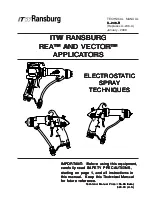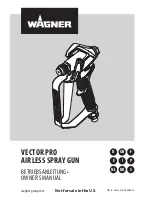
C ompone nt Ide ntification
KP330
–
Electric Piston Airless Sprayer
WARNING
EQUIPMENT MISUSE HAZARD
Misuse can cause death or serious injury.
Do not exceed the maximum working pressure or temperature rating of the lowest
rated system component. Read Technical Data in all equipment manuals.
Use fluids and solvents that are compatible with equipment wetted parts. Read
Technical Data in all equipment manuals. Read fluid and solvent manufacturer's
warnings.For complete information about your material, request MSDS from
distributor or retailer.
Check equipment daily. Repair or replace worn or damaged parts immediately.
Do not alter or mod ify equipment.
Route hoses and cables away from traffic areas, sharp edges, moving parts, and hot
surfaces.
Do not kink or overbend hoses or use hoses to pull equipment.
Comply with all applicable safety regulations.
Keep children and animals away from work area.
Do not operate the unit when fatigued or under the influence of drugs or alcohol.
ELECTRIC SHOCK HAZARD
Improper grounding, setup, or usage of the system can cause electric shock.
Turn off and disconnect power cord before servicing equipment.
Use only grounded electrical outlets.
Use only 3-wire extension cords.
Ensure ground prongs are intact on sprayer and extension cords.
Do not expose to rain. Store indoors.
PRESSURIZED ALUMINUM PARTS HAZARD
Do not use 1,1,1 -trichloroethane, methylene chloride, and/or other halogenated
hydrocarbon solvents or fluids containing such solvents in pressurized aluminum
equipment. Such use can cause serious chemcal reaction and equipment rupture,
and result in death, serious injury, and/or property damage.
TOXIC FLUID OR FUMES HAZARD
Toxic fluids or fumes can cause serious injury or death if splashed in the eyes or on
skin, inhaled, or swallowed.
Read MSDS’s to know the specific hazards of the fluids you ar
e using.
Store hazardous fluid in approved containers and dispose of it according to
applicable guidelines.
PERSONAL PROTECTIVE EQUIPMENT
You must wear appropriate protective equipment when operating, servicing, or when in
the operating area of the equipment to help protect you from serious injury, including
eye injury, inhalation of toxic fumes, burns, and hearing loss. This equipment includes,
but is not limited to:
Protective eye wear
Clothing and respirator as recommended by the fluid and solvent manufacturer
Gloves
Hearing protection
FN
Component
ON/OFF switch
P ressure control
P rime valve
Manifold
P ump




























